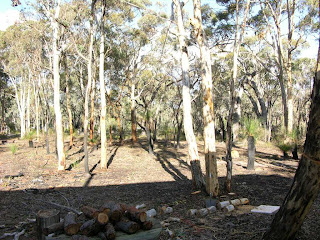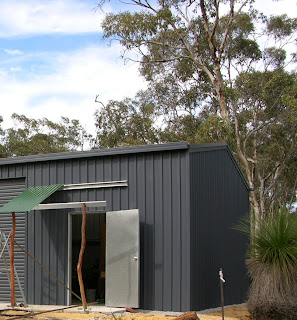A large eucalypt tree in the general category referred to as a "White Gum," but probably a kind of Wandoo was overhanging the Shed and dropping its leaves onto the roof, contaminating the rainwater that I depend on. It can be seen in this picture, in the upper right-hand corner. Because the tree was overhanging the shed and threatening to smash it when cut down, Geoff offered to help out with his truck and a rope to pull on it. But when he came to inspect the tree more closely, he turned right around and said, "Can't do it. Leaning too far over. It'll drag my truck right along the ground and smash your shed anyway." So I had to figure out another way. Did I mention the tree was over 60 feet tall?
"If only I had a 1-inch steel cable, roughly 200 feet long," I said to no one in particular. "Like the kind that mores ships to a dock. If I had something like that I reckon I could sort this tree with no trouble at all." A few weeks later I was down at the back of the block fossicking around in the junk that the previous owner had left. Isn't fossicking a great word? It's Australian for "rummaging." I was out fossicking around, and you'll never credit what I came up with. A 1-inch steel cable roughly 200 feet long. Coiled up inside an old oil drum.
To quote the immortal Dave Barry , I am NOT making this up!
, I am NOT making this up!
I dragged it out and made a loop in one end. I tied a light line to a heavy stick and managed to throw it over a large branch of the tree. The line was used it to hoist over a stout rope. I used the rope to carry up the very heavy steel cable and slip-knotted it around the tree. The other end of the cable was anchored to the base of another large tree some 100 feet away in the direction away from the Shed, and away from the lean of the tree.
One problem: a large branch of another tree was in the way of the cable, so it had to come off. If Funniest Home Videos teaches us nothing else, it is that guys on ladders with chainsaws will always come to grief. That, and no one has ever approached a trampoline without injuring themselves and then being sniffed by a dog. Also, piñatas are to be avoided AT ALL COSTS, unless you are wearing a cup. The reason a guy will always fall off the ladder when he cuts a large branch off a tree is simple physics. What's holding up the branch? The tree, of course. How is it doing it? By applying stress through the trunk of the tree. What happens when that stress is suddenly removed? Lots happens!
teaches us nothing else, it is that guys on ladders with chainsaws will always come to grief. That, and no one has ever approached a trampoline without injuring themselves and then being sniffed by a dog. Also, piñatas are to be avoided AT ALL COSTS, unless you are wearing a cup. The reason a guy will always fall off the ladder when he cuts a large branch off a tree is simple physics. What's holding up the branch? The tree, of course. How is it doing it? By applying stress through the trunk of the tree. What happens when that stress is suddenly removed? Lots happens!
I knew the tree would recoil violently when a branch weighing several hundred pounds was suddenly no longer attached to it, so I lashed the ladder tightly to the tree. I also planted a cement base for the ladder to rest on (visible in photo). And when I made the cut, I didn't allow the branch to gradually swing down like a pendulum and knock me off the ladder; I went right through the branch as fast as the chainsaw would take me. The branch recoiled like a diving board, vibrating on its primary mode in free-fall and fell nearly straight down. Still, the cut end of the branch took out a large chunk of bark from the trunk of the tree (visible in photo as a yellowish patch halfway up the trunk), narrowly missing the ladder I was on. As soon as the cut was complete, I clapped on to the tree and held on tight. The tree shook violently, but I stayed with it and, importantly, I did not loose the ladder. (The photo shows a long-handled shovel for scale, the cable visible going overhead, and the cut branch on the ground ready for drying. On the far right side is the tree I am attempting to bring down, with a mark where the fell cut would be made.)
To quote the immortal Dave Barry
 |
| Anchoring the cable |
One problem: a large branch of another tree was in the way of the cable, so it had to come off. If Funniest Home Videos
 |
| Click to see larger image. |
Later I acquired a second-hand 3-ton chain hoist (ex-rental) and used it to take the slack out of the cable. Then after taking one last look around, I was satisfied that I had taken every precaution. The tree, according to my calculations, would fall on a line perpendicular to the cable and about 30 degrees away from the Shed, missing it with all of its branches. Every angle was correct. My position would also be perfectly safe. I fired up the chain saw.
 |
| The cable slip-knotted over a fork in the tree that was originally 30 feet off the ground. The rope used to hoist up the cable is still attached. |
After chewing through a bit more of the 14 inch diameter trunk, the tree popped again, gave a shiver, and seemed to go slack. It came over all lazy and swayed there as though it were about to faint. That distinctly lower-frequency motion indicated to the vibrational engineer in me that the tree had almost no stiff support any longer, and was simply balancing in space. I dropped the chain saw once more and ran back to the hoist. I didn't have to haul on it very much before the tree began a long, slow-motion tilt, picking up speed, and rushing faster and faster towards the ground. It made an almighty CRUNCH!, broke into several large pieces, and then lay still.



No comments:
Post a Comment